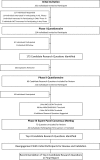Moving Forward Through Consensus: A Modified Delphi Approach to Determine the Top Research Priorities in Orthopaedic Oncology
- PMID: 28856514
- PMCID: PMC5670064
- DOI: 10.1007/s11999-017-5482-7
Moving Forward Through Consensus: A Modified Delphi Approach to Determine the Top Research Priorities in Orthopaedic Oncology
Abstract
Background: Several challenges presently impede the conduct of prospective clinical studies in orthopaedic oncology, including limited financial resources to support their associated costs and inadequate patient volume at most single institutions. This study was conducted to prioritize research questions within the field so that the Musculoskeletal Tumor Society (MSTS), and other relevant professional societies, can direct the limited human and fiscal resources available to address the priorities that the stakeholders involved believe will have the most meaningful impact on orthopaedic oncology patient care.
Questions/purposes: The purpose of this study was to use a formal consensus-based approach involving clinician-scientists and other stakeholders to identify the top priority research questions for future international prospective clinical studies in orthopaedic oncology.
Methods: A three-step modified Delphi process involving multiple stakeholder groups (including orthopaedic oncologists, research personnel, funding agency representation, and patient representation) was conducted. First, we sent an electronic questionnaire to all participants to solicit clinically relevant research questions (61 participants; 54% of the original 114 individuals invited to participate returned the questionnaires). Then, participants rated the candidate research questions using a 5-point Likert scale for five criteria (60 participants; 53% of the original group participated in this portion of the process). Research questions that met a priori consensus thresholds progressed for consideration to an in-person consensus meeting, which was attended by 44 participants (39% of the original group; 12 countries were represented at this meeting). After the consensus panel's discussion, members individually assigned scores to each question using a 9-point Likert scale. Research questions that met preset criteria advanced to final ranking, and panel members individually ranked their top three priority research questions, resulting in a final overall ranking of research priorities.
Results: A total of 73 candidate research questions advanced to the consensus meeting. In the end, the consensus panel identified four research priorities: (1) Does less intensive surveillance of patients with sarcoma affect survival? (2) What are the survival outcomes over time for orthopaedic oncology implants? (3) Does resection versus stabilization improve oncologic and functional outcomes in oligometastatic bone disease? (4) What is the natural history of untreated fibromatosis?
Conclusions: The results of this study will assist in developing a long-term research strategy for the MSTS and, possibly, the orthopaedic oncology field as a whole. Furthermore, the results of this study can assist researchers in guiding their research efforts and in providing a justified rationale to funding agencies when requesting the resources necessary to support future collaborative research studies that address the identified orthopaedic oncology priorities.
Figures
Comment in
-
CORR Insights®: Moving Forward Through Consensus: A Modified Delphi Approach to Determine the Top Research Priorities in Orthopaedic Oncology.Clin Orthop Relat Res. 2017 Dec;475(12):3056-3059. doi: 10.1007/s11999-017-5501-8. Epub 2017 Sep 19. Clin Orthop Relat Res. 2017. PMID: 28929405 Free PMC article. No abstract available.
Similar articles
-
Moving forward through consensus: protocol for a modified Delphi approach to determine the top research priorities in the field of orthopaedic oncology.BMJ Open. 2016 May 24;6(5):e011780. doi: 10.1136/bmjopen-2016-011780. BMJ Open. 2016. PMID: 27221129 Free PMC article.
-
Establishing a set of research priorities in care homes for older people in the UK: a modified Delphi consensus study with care home staff.Age Ageing. 2017 Mar 1;46(2):284-290. doi: 10.1093/ageing/afw204. Age Ageing. 2017. PMID: 27852597 Free PMC article.
-
Establishing a consensus on research priorities in orthopaedic trauma within South Africa.Eur J Orthop Surg Traumatol. 2023 Apr;33(3):533-540. doi: 10.1007/s00590-022-03413-w. Epub 2023 Feb 8. Eur J Orthop Surg Traumatol. 2023. PMID: 36752822
-
Top research priorities in liver and gallbladder disorders in the UK.BMJ Open. 2019 Mar 7;9(3):e025045. doi: 10.1136/bmjopen-2018-025045. BMJ Open. 2019. PMID: 30850408 Free PMC article. Review.
-
Identifying top 10 primary care research priorities from international stakeholders using a modified Delphi method.PLoS One. 2018 Oct 25;13(10):e0206096. doi: 10.1371/journal.pone.0206096. eCollection 2018. PLoS One. 2018. PMID: 30359391 Free PMC article.
Cited by
-
Willingness of patients with sarcoma to participate in cancer surveillance research: a cross-sectional patient survey.BMJ Open. 2021 Feb 26;11(2):e042742. doi: 10.1136/bmjopen-2020-042742. BMJ Open. 2021. PMID: 33637543 Free PMC article.
-
Statistical Fragility of Surgical and Procedural Clinical Trials in Orthopaedic Oncology.J Am Acad Orthop Surg Glob Res Rev. 2020 Jun 1;4(6):e19.00152. doi: 10.5435/JAAOSGlobal-D-19-00152. eCollection 2020 Jun. J Am Acad Orthop Surg Glob Res Rev. 2020. PMID: 32656478 Free PMC article.
-
Examining patient perspectives on sarcoma surveillance: The Sarcoma Surveillance Survey.Surg Oncol. 2022 Dec;45:101861. doi: 10.1016/j.suronc.2022.101861. Epub 2022 Oct 4. Surg Oncol. 2022. PMID: 36270157 Free PMC article.
-
Short and mid-term research priorities for Veterans with multiple sclerosis: A modified Delphi process engaging Veterans, researchers, and operational partners.Mult Scler Relat Disord. 2025 Feb;94:106267. doi: 10.1016/j.msard.2025.106267. Epub 2025 Jan 12. Mult Scler Relat Disord. 2025. PMID: 39862462
-
The Surveillance After Extremity Tumor Surgery (SAFETY) trial: protocol for a pilot study to determine the feasibility of a multi-centre randomised controlled trial.BMJ Open. 2019 Sep 18;9(9):e029054. doi: 10.1136/bmjopen-2019-029054. BMJ Open. 2019. PMID: 31537562 Free PMC article.
References
-
- American Academy of Orthopaedic Surgeons. Metastatic Bone Disease. Available at: http://orthoinfo.aaos.org/topic.cfm?topic=A00093. Accessed May 12, 2017.
Publication types
MeSH terms
LinkOut - more resources
Full Text Sources
Other Literature Sources
Miscellaneous


